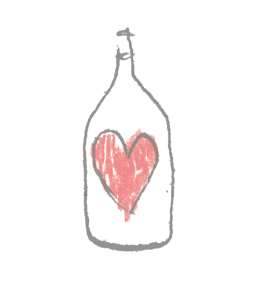A difficult year in Sauternes, but thanks to very small yields, Mireille Daret has succeeded in creating a nice gastronomic wine, ideal with Thai cuisine!
“The successes of the vintage: The 1992 vintage follows, in the same way, the superb 1991. Completely erasing the harmful effects of the vintage, the cru has once again produced a masterstroke thanks to exemplary sorting and sorting. Remarkable.” La Revue du Vin de France, September 1996
“Very rich but still elegant, superb material, well vinified. 2000 – 2020” Le guide d’achat des Crus 1996, R.V.F. September 1996
The 1992 vintage as seen by Mireille Daret:
The winter of 1992 was very dry, close to records. It rained during the summer, but more than half of these rains fell in 5 days! In addition, 1992 was a very hot year: minimum and maximum temperatures were above seasonal norms from April to August, with 63 days above 25°C compared to 54°C on average, and 21 days above 30°C compared to 15°C normally. At the end of the summer we had grapes of high aromatic quality with an early ripening. The sugar levels measured during the first grape samples taken from our vineyard in mid-September were exceptionally high.
The rain made it difficult for us when we should have started the harvest. The humidity was very favourable to the development of botrytis, but we had to wait for a dry period before the concentration by evaporation which follows the development of botrytis could occur. The sun having returned, the concentration of sugars and aromas was rapid. We have decided to employ a lot of staff in order to quickly sort the grapes from the 13000 or so vines that flourish on the two hectares of the Cru Barréjats… Thus, from 8 to 16 October, about twenty people carried out two sortings, and the third sorting could be carried out from 7 to 9 November! More than ever in Sauternes, the quality of the wines of the 1992 vintage was played out during the harvest. The “Sauternes sorting” grain by grain allowed us to select the grapes and thus produce a great Sauternes wine.
In the winery, our vertical hydraulic press gave us quality musts because they were concentrated and low in sludge. After cold settling in a stainless steel tank refrigerated at 8°C, we tasted and rigorously selected the musts that fermented in new barrels, in a cellar whose temperature we control. The very tight-grained stave oak barrels are fine-grained to allow the best oxidative exchanges through the wood, and medium toast (Mercier and Taransaud, same choice as for the 1991 vintage). The cessation of fermentation has benefited from refrigeration technology, which has allowed us to reduce the addition of sulphur. During the ageing process, we have taken care to preserve the identity of each barrel over time. After 20 months of ageing, in July 1994 we bottled the 1992 Cru Barréjats: 3,600 bottles of a great Sauternes, i.e. a yield of 13.5 hectolitres per hectare (compared to the 25 hectolitres usually authorised in the Sauternes appellation).
CRU BARREJATS 1992

| Région | Bordeaux |
|---|---|
| Designation | Sauternes |
| Color | sweet |
| Vintage | 1992 |
| Label | AUCUN |
| Capacity | 75cl |
CRU BARREJATS
A difficult year in Sauternes, but thanks to very small yields, Mireille Daret has succeeded in creating a nice gastronomic wine, ideal with Thai cuisine!
"The successes of the vintage: The 1992 vintage follows, in the same way, the superb 1991. Completely erasing the harmful effects of the vintage, the cru has once again produced a masterstroke thanks to exemplary sorting and sorting. Remarkable." La Revue du Vin de France, September 1996
"Very rich but still elegant, superb material, well vinified. 2000 - 2020" Le guide d'achat des Crus 1996, R.V.F. September 1996
The 1992 vintage as seen by Mireille Daret:
The winter of 1992 was very dry, close to records. It rained during the summer, but more than half of these rains fell in 5 days! In addition, 1992 was a very hot year: minimum and maximum temperatures were above seasonal norms from April to August, with 63 days above 25°C compared to 54°C on average, and 21 days above 30°C compared to 15°C normally. At the end of the summer we had grapes of high aromatic quality with an early ripening. The sugar levels measured during the first grape samples taken from our vineyard in mid-September were exceptionally high.
The rain made it difficult for us when we should have started the harvest. The humidity was very favourable to the development of botrytis, but we had to wait for a dry period before the concentration by evaporation which follows the development of botrytis could occur. The sun having returned, the concentration of sugars and aromas was rapid. We have decided to employ a lot of staff in order to quickly sort the grapes from the 13000 or so vines that flourish on the two hectares of the Cru Barréjats... Thus, from 8 to 16 October, about twenty people carried out two sortings, and the third sorting could be carried out from 7 to 9 November! More than ever in Sauternes, the quality of the wines of the 1992 vintage was played out during the harvest. The "Sauternes sorting" grain by grain allowed us to select the grapes and thus produce a great Sauternes wine.
In the winery, our vertical hydraulic press gave us quality musts because they were concentrated and low in sludge. After cold settling in a stainless steel tank refrigerated at 8°C, we tasted and rigorously selected the musts that fermented in new barrels, in a cellar whose temperature we control. The very tight-grained stave oak barrels are fine-grained to allow the best oxidative exchanges through the wood, and medium toast (Mercier and Taransaud, same choice as for the 1991 vintage). The cessation of fermentation has benefited from refrigeration technology, which has allowed us to reduce the addition of sulphur. During the ageing process, we have taken care to preserve the identity of each barrel over time. After 20 months of ageing, in July 1994 we bottled the 1992 Cru Barréjats: 3,600 bottles of a great Sauternes, i.e. a yield of 13.5 hectolitres per hectare (compared to the 25 hectolitres usually authorised in the Sauternes appellation).
Learn more >
"The successes of the vintage: The 1992 vintage follows, in the same way, the superb 1991. Completely erasing the harmful effects of the vintage, the cru has once again produced a masterstroke thanks to exemplary sorting and sorting. Remarkable." La Revue du Vin de France, September 1996
"Very rich but still elegant, superb material, well vinified. 2000 - 2020" Le guide d'achat des Crus 1996, R.V.F. September 1996
The 1992 vintage as seen by Mireille Daret:
The winter of 1992 was very dry, close to records. It rained during the summer, but more than half of these rains fell in 5 days! In addition, 1992 was a very hot year: minimum and maximum temperatures were above seasonal norms from April to August, with 63 days above 25°C compared to 54°C on average, and 21 days above 30°C compared to 15°C normally. At the end of the summer we had grapes of high aromatic quality with an early ripening. The sugar levels measured during the first grape samples taken from our vineyard in mid-September were exceptionally high.
The rain made it difficult for us when we should have started the harvest. The humidity was very favourable to the development of botrytis, but we had to wait for a dry period before the concentration by evaporation which follows the development of botrytis could occur. The sun having returned, the concentration of sugars and aromas was rapid. We have decided to employ a lot of staff in order to quickly sort the grapes from the 13000 or so vines that flourish on the two hectares of the Cru Barréjats... Thus, from 8 to 16 October, about twenty people carried out two sortings, and the third sorting could be carried out from 7 to 9 November! More than ever in Sauternes, the quality of the wines of the 1992 vintage was played out during the harvest. The "Sauternes sorting" grain by grain allowed us to select the grapes and thus produce a great Sauternes wine.
In the winery, our vertical hydraulic press gave us quality musts because they were concentrated and low in sludge. After cold settling in a stainless steel tank refrigerated at 8°C, we tasted and rigorously selected the musts that fermented in new barrels, in a cellar whose temperature we control. The very tight-grained stave oak barrels are fine-grained to allow the best oxidative exchanges through the wood, and medium toast (Mercier and Taransaud, same choice as for the 1991 vintage). The cessation of fermentation has benefited from refrigeration technology, which has allowed us to reduce the addition of sulphur. During the ageing process, we have taken care to preserve the identity of each barrel over time. After 20 months of ageing, in July 1994 we bottled the 1992 Cru Barréjats: 3,600 bottles of a great Sauternes, i.e. a yield of 13.5 hectolitres per hectare (compared to the 25 hectolitres usually authorised in the Sauternes appellation).
Other products in the domain CRU BARREJATS
-
More
info
CRU BARREJATS-DARET 2011 75cl
CRU BARREJATSSauternes45,00 € + -
More
info
CRU BARREJATS-DARET 2010 75cl
CRU BARREJATSSauternes45,00 € + -
More
info
CRU BARREJATS EN MAGNUM 2003 150cl
CRU BARREJATSSauternes120,00 € + -
More
info
CRU BARREJATS EN MAGNUM 1999 150cl
CRU BARREJATSSauternes105,00 € + -
More
info
CRU BARREJATS 1998 75cl
CRU BARREJATSSauternes50,00 € + -
More
info
CRU BARREJATS 2002 75cl
CRU BARREJATSSauternes50,00 € +







